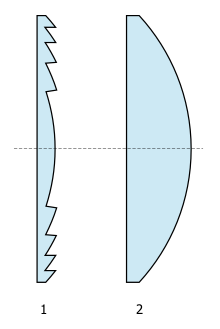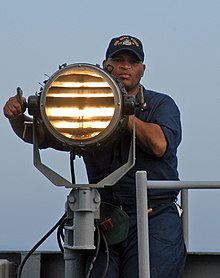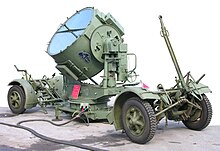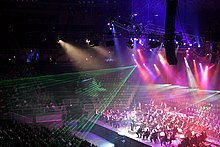Headlights

The headlight is a lamp in which the light generated by a light source ( e.g. incandescent lamp , gas discharge lamp , arc lamp , light-emitting diode ) is directed in one direction by sharply bundling the light rays ( reflection or refraction ).
An object illuminated by headlights is highlighted. This is usually desirable (for example in stage technology).
The large amount of heat generated must be considered in the design.
Layout and function
Headlights consist of a light source ( lamp , light source), a reflector , a transparent glass pane (as protection and possibly as a diffuser ) and (rarely) optical lenses . These elements are located in a housing that is often movable. The light is bundled by the reflector and exits to the front, depending on the position, shape and combination of the lenses, scattered or bundled. The glass or possibly the color filter are the last links in the beam path .
The reflector can be a spherical cap or a parabolic mirror , depending on whether it effects the bundling alone or together with a condenser lens . When a certain light distribution is to be achieved, e.g. B. in a vehicle headlight , a free-form reflector is often used. The reflector can be solidly metallic, surface mirrored or rear surface mirrored ( Mangin mirror ). The mirror layer can be a metal (mostly aluminum) or an interference mirror ( dichroic mirror , e.g. in cold light mirror lamps ).
The emerging light can be colored by a colored glass filter or by dichroic reflectors or filters. The light source itself can also be colored or provided with color filters. Headlights can be fitted with heat protection filters to reduce the heating of the illuminated objects.
Headlights are used on vehicles, on stages, for film / photo recordings, for architectural and event lighting, etc.
Headlight types
- Floodlights - usually a parabolic trough mirror with an elongated light source, for example a rod-shaped halogen lamp, a high-pressure gas discharge lamp with a long arc (long arc lamp); it emits the light widely. Floodlights have a very high light output and are used to illuminate large areas (e.g. sports stadiums, train stations, ports).

- Mirror headlights - the light source is at the focal point of a parabolic mirror, if necessary with a variable distance. Light source: Tungsten, or short-arc gas-discharge lamp ( xenon-high pressure lamp , metal halide lamp )
-
Lens headlights (projection headlights , planoconvex or PC headlights) - light source (types as before) is near the center of a spherical mirror , in front of it is a planoconvex lens, which depicts the light source and its reflection in infinity. The exit angle of the light can often be changed by changing the distance between the light source and the lens.
- Headlights with stepped or Fresnel lens (after the inventor of the lens Augustin Jean Fresnel ), also Fresnel lens headlights : In large models, the thickness of the lens in the middle would be too big and the glass would be too heavy and would crack easily. Therefore the convex curvature is graded in several concentric rings.
- Profile spotlights - projection
use
Vehicles, planes
Headlights on vehicles (headlights) and aircraft (landing lights) are used for road safety by making the vehicle or aircraft visible and illuminating the route when driving or landing in the dark. Headlights on motor vehicles are parabolic mirror headlights, clear glass headlights with free-form reflectors or projection headlights .
Military use of searchlights
Large, powerful headlights with carbon arc lamps have been used since the First World War , and especially during World War II . So z. B. in the air defense as support of the flak , as markings for artillery and as searchlights of ships. The standard versions of these spotlights consisted of a 1.5 meter (“150”) or two meter (“200”) parabolic mirror with an arc lamp made of two pressed tungsten carbon rods in its focus . The front opening of the parabolic headlamp was closed with heat-resistant quartz glass in the form of a round lid and could be opened for renewal of the carbon rods and maintenance. The arrangements required a high electrical output (approx. 12-15 kilowatts), which was generated by gasoline or diesel-powered power units or by a generator on board a truck carrying the headlight with its drive motor. A 1.5 m headlight had a luminous intensity of 1 G cd .
The beam of light generated by the anti-aircraft headlights reached up to twelve kilometers, depending on the weather. During the Second World War, the six to eight-person operators of the headlights tried to dazzle the "Scout" ("Pathfinder") flying at the head of the enemy bombers and thus rob him of his view and orientation.
The light beam from the headlights was also used to illuminate enemy aircraft flying in the formation in order to provide the air defense with clearly visible targets. The lighting of enemy aircraft over large cities worked so well that the air force even used day fighters to fight the bombers (" Wilde Sau "). As a rule, the light cones from five headlights stationed within a radius of about five kilometers (four 150s and a 200 in the middle as a guide beam) were bundled.
During the Second World War, the British had "Canal defense lights" as a secret weapon . These were not, as the name suggests, installed on the English Channel, but mobile on tanks. The light fell from a narrow gap in the turret of special tanks (larger mirrors would have been too easy a target for projectiles).
Carbon arc lamp headlights were also in use in the Soviet Union and Warsaw Pact states until at least 1978 . Such spotlights were also used by the border troops of the GDR . The aim was to illuminate certain lake areas in a deterrent manner. This was practiced there until at least 1984. Such headlights had an automatic carbon pen adjustment device that operated with an electric motor and a thermal switch illuminated by a collective lens .
During the Second World War, the closest network of searchlights was drawn around what was then the capital of the Reich, Berlin. In the western approach lane of the enemy bombers, a continuous wall of light could be formed from Werder and Wildpark near Potsdam via Ketzin in Havelland and the transmission systems in Nauen ( Germany's transmitter ) to Kremmen and Oranienburg (35 km north of Berlin). The searchlight crews were stationed in positions in the open field in remote locations with an open light field. Mainly high school students from Saxony were deployed as flak helpers in these positions .
Infrared headlights
Infrared headlights radiate in the near infrared and are used in conjunction with night vision devices or residual light amplifiers for invisible illumination of possible targets or attackers, or to illuminate the surveillance area. Powerful infrared headlights are designed like conventional headlights; metal halide lamps and high-pressure mercury vapor lamps are particularly suitable as light sources . However, they have blocking filters for the visible part of the radiation of the lamp, which anyway mainly radiates in the infrared. Since the blocking filters reflect a large part of the light rays into the interior of the lamp, the generation of heat is greater than with comparable headlights without blocking filters. That is why technical measures for heat dissipation are used in these headlights.
Small infrared headlights can also be implemented with infrared light-emitting diodes ; these do not require any filters. Since a single light-emitting diode has only a weak luminosity, many diodes are used in the headlights. These headlights are mainly used for object surveillance in connection with infrared-sensitive surveillance cameras.
CCD or CMOS sensors, as used in digital and video cameras, detect infrared light.
Headlights for signal transmission

From the 1830s on, there were successive technical improvements in Morse code . On ships in particular, there were and are spotlights with shutter locks that are used to transmit signals over long distances between ships by opening and closing the blinds by hand in the rhythm of Morse code. Since radio transmitters can be located (" radio direction finding ") and since radio messages have been intercepted, communication between ships, between submarines that have surfaced or between ships and submarines using light signals has been (and still is) of considerable importance.
Small incandescent lamps or LEDs can be electrically modulated and used for voice transmission ( light telephone ). During the Second World War attempts were made to use arc lamps to transmit encrypted signals over long distances. Up to five simultaneous voice channels were successfully tested. The transmission route was 18.2 km long.
"Light domes" for propaganda

For the first time, headlights were used for propaganda purposes in Germany during the Nazi era . The then building minister Albert Speer (1905–1981) developed his own technology for the "building material light" by bundling headlights at the 1936 Summer Olympics into a so-called light dome . At the Nazi party rallies in Nuremberg, hundreds of thousands of Adolf Hitler's supporters were put into a spectacular pseudo-sacred mood on the zeppelin field in the evening hours (see also the Führer cult ). To form the light dome, 152 motorized flak headlights and 2000 other fixed light sources with an output of 3100 kW were used. The light productions evoking the Nazi spirit were prepared in the documentary “ Triumph des Willens ” by the then star director Leni Riefenstahl (1902–2003) in terms of propaganda and art.
Individual light cones generated in the sky during the darkness are also called sky radiators .
Event technology

In event technology, in addition to conventional spotlights, spotlights with variable, remote-controlled colors, radiation geometries, directions and intensities are used, which are often controlled from a computer or control panel according to the stage directions. Motorized, movable headlights ( moving lights ) are available with two technologies: With the moving head , the entire headlight moves, with the scanner motorized mirrors direct the light.
The headlights have motorized swivel axes, color wheels (circular, rotatable color filters with different color segments), movable lenses and mirrors as well as bezels. The intensity is controlled with triac controls .
To illuminate soloists, there are tracking systems that always align the light cone of a spotlight to the performer, who for this purpose z. B. carries an ultrasonic transmitter.
Also flash lamps often have reflectors for directional radiation.
See also: PAR spotlights , theater lighting , event technology
Film / photo recordings
Film , television and photo studios have spotlights. Here they serve to improve the image quality. Shorter exposure times or smaller apertures can be used, so that the motion blur is reduced and the depth of field increased.
Together with diffuse reflective screens, they serve for better, softer illumination, especially of faces.
In photo studios, flash lights are used that contain a conventional light source and a flash lamp, both of which have the same radiation characteristics.
Headlights are also used for outdoor shoots (filming outside of buildings) to improve lighting or to change the mood (e.g. blue light for night scenes, simulation of solar radiation). One of the most powerful spotlights currently available for simulating daylight is the Arrimax 18/12. With the 18 kW HMI lamp, the spotlight creates 129,960 lux over a distance of 10 m.
Artificial landscape backgrounds are created with powerful projectors on a canvas .
Other forms
Hand lamps are used, among other things, by the fire brigade or as emergency lighting (in the event of power failures). They are battery-operated or have a plug for the electrical system of a motor vehicle. In a broader sense, this also includes flashlights and miner's lamps .
Video projectors and other projectors ( film projectors , slide projectors ) also generate a directed light emission, which is constructed in the same way as a projection spotlight.
Lighthouses and rotating beacons have a fixed light source (usually light bulb) rotating optical components for focusing. For rotating beacons this is a parabolic reflector, for lighthouses a projection spotlight with a Fresnel lens.
See also
literature
- Heinz Haferkorn: Optics: physical-technical basics and applications . 3rd edition, Barth Verlagsgesellschaft mbH, Leipzig Berlin Heidelberg 1994, p. 626, ISBN 3-335-00363-2
Web links
Individual evidence
- ↑ Ernst Schluchtmann: The service instruction in the flak cartillery. Edition for the flak searchlight gunner. (PDF; 12.6 MB) In: The research and documentation of the Bochumer Bunker e. V. Bochum study group for bunkers, tunnels, cover ditches and underground manufacturing plants e. V., 1939, p. 127 , accessed on April 13, 2013 : "With a light intensity of 1100 million Hefner candles , it has a range of 10–12 km in favorable weather conditions."
- ↑ see also English Wikipedia
- ↑ Michael Gwozdek: Lexicon of video surveillance technology: planning, advice, installation. On: books.google.de. Verlag Hüthig Jehle Rehm, 2007, ISBN 3609684321 , p. 64 f.
- ↑ Wolfgang Schivelbusch : Light, appearance and delusion. Appearance of electric lighting in the 20th century. Ernst & Sohn, Berlin 1992, ISBN 3-433-02344-1 , p. 82.





